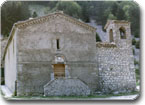MONTEMONACO
CHURCH OF SAN GIORGIO ALL'ISOLA
CHURCH OF DI SAN LORENZO IN VALLEGRASCIA
CHURCH OF SANTA MARIA IN CASALICCIO
CHURCH OF SAN BIAGIO
CHURCH OF SAN BENEDETTO ABBATE
| Ha origini molto antiche, ma fu ricostruita nel 1546, come testimonia la data scolpita sul portale; in quell’anno furono terminati il portale cuspidato, in pietra tufacea, che ancor’oggi si può ammirare, e la facciata. La chiesa é incorporata nel sistema delle mura, infatti utilizza un torrione della cinta come campanile.All’interno essa include l’abside della chiesa di S. Biagio e custodisce: un Crocefisso ligneo policromo della fine del XV sec., un affresco della fine del ‘400, una tela seicentesca e la reliquia del Braccio di S. Benedetto. |
CHURCH OF DI SAN GIOVANNI BATTISTA
CHURCH OF SAN MICHELE ARCANGELO
| Located at about 1 Km from Montemonaco, on the road to Amandola, the little church dedicated to S. Michele, in Romanesque style, has a precious ogive doorway. The church dates back to the 14th century and has a semi-circular apse. |
CHURCH OF SAN BARTOLOMEO

|
(FRAZIONE FOCE) Standing on the ruins of an ancient abbey, it has been restored by Don Brunori, a local parish priest. |
Copyright © 2007 Parco Nazionale dei Monti Sibillini
Tutti i diritti riservati - All rights reserved
Revised -- 20/08/2007
URL:
http://www.sibillini.net/en/il_parco/cultura_territorio/edifici_di_culto/montemonaco.php